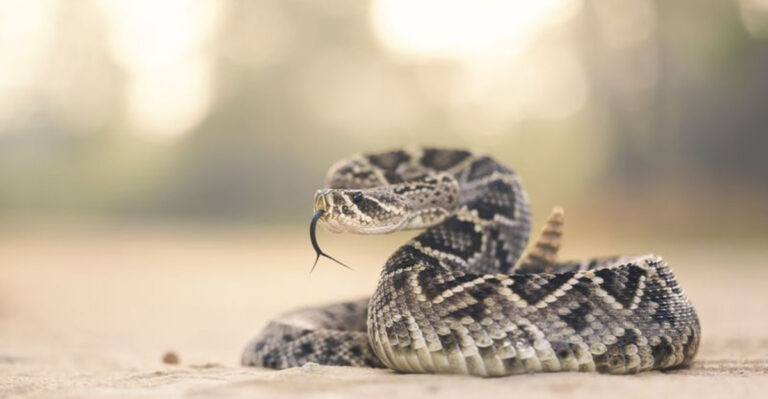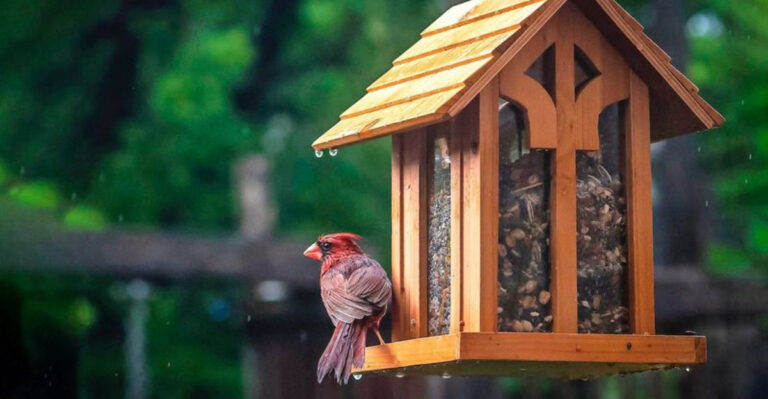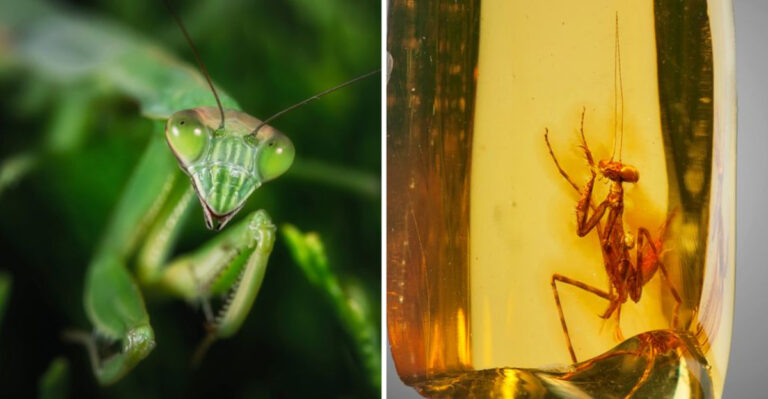15 Birds That Build The Most Elaborate Nests
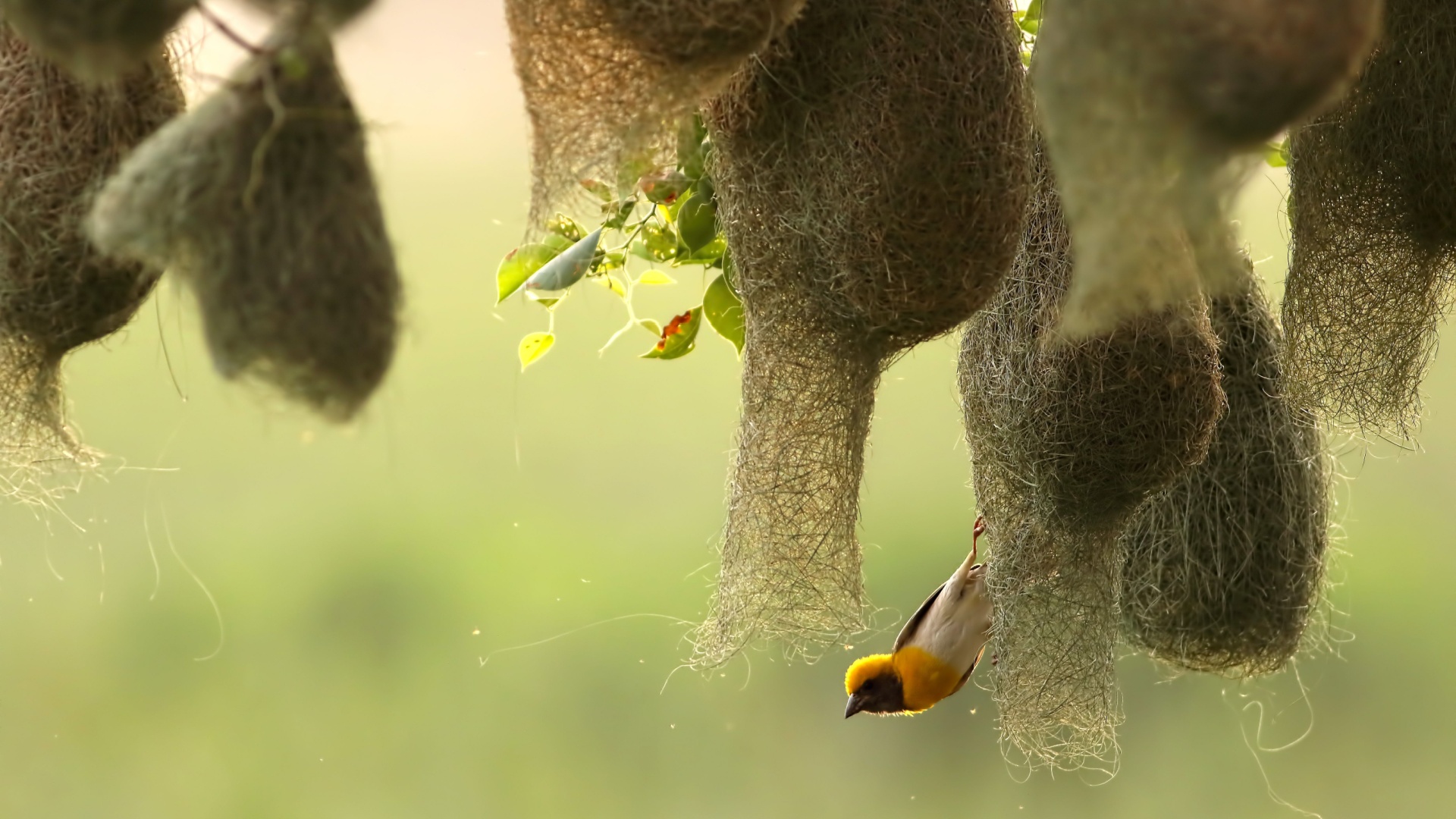
Birds are nature’s architects, crafting intricate and stunning nests that can both fascinate and perplex the human observer.
These avian structures, varying widely in complexity and size, serve not only as a cradle for their young but also as a testament to the diverse ingenuity of their builders.
Let’s explore this list of birds renowned for constructing some of the most elaborate nests in the avian world. From towering edifices to delicate weavings, these birds showcase an unparalleled mastery in nest-building.
1. Bowerbird
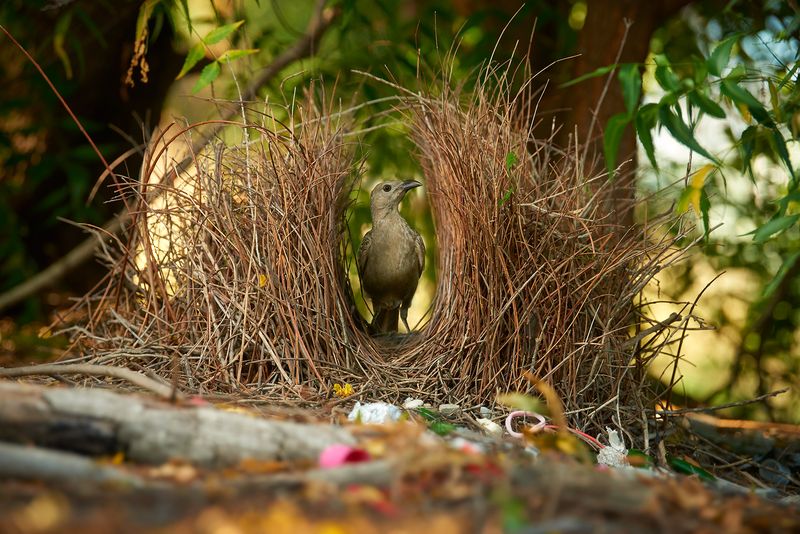
The bower of a Bowerbird is a marvel of avian engineering. Hidden within the Australian forests, these birds construct elaborate structures purely for courtship displays. Unlike typical nests, the bower doesn’t serve as a home, but as an art gallery to attract mates.
Built from twigs and decorated with colorful objects found in the environment, including flowers, berries, and even bits of plastic, the bower showcases the male’s creativity and skill.
Each species of Bowerbird has its unique style, often preferring specific colors. The Satin Bowerbird, for instance, is partial to blue items, creating a vibrant and visually appealing display. This intricate construction is not just about aesthetics; it plays a crucial role in mating success.
Females visit these bowers, inspecting them meticulously before selecting a partner, making the bowerbird’s nest-building prowess critical for reproductive success.
2. Sociable Weaver
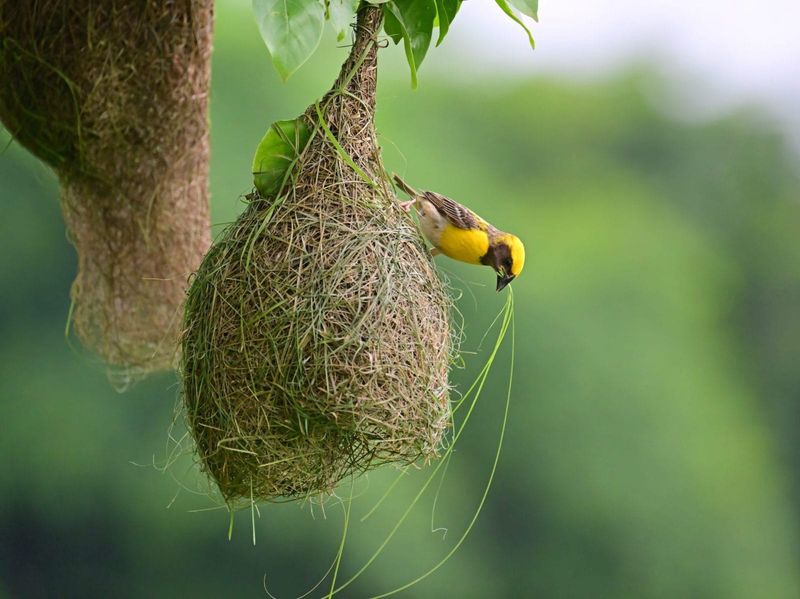
In the arid landscapes of the Kalahari, Sociable Weavers build some of the largest nests known to birds. These structures, resembling thatched roofs, are true marvels of communal living. Constructed from twigs and grasses, a single nest can house hundreds of birds, each pair having its own chamber.
The nests offer insulation against the harsh desert temperatures, keeping the interior cool during the day and warm at night. These communal nests can persist for generations, growing continuously as new material is added.
The Sociable Weaver’s construction is meticulously organized, with separate chambers for sleeping and breeding.
Predators, however, must beware of sharp thorns that often cover the exterior, a natural defense mechanism. Observing these nests, one can’t help but appreciate how the Sociable Weaver has adapted its nesting strategy to thrive in one of the world’s most unforgiving environments.
3. Weaver Bird
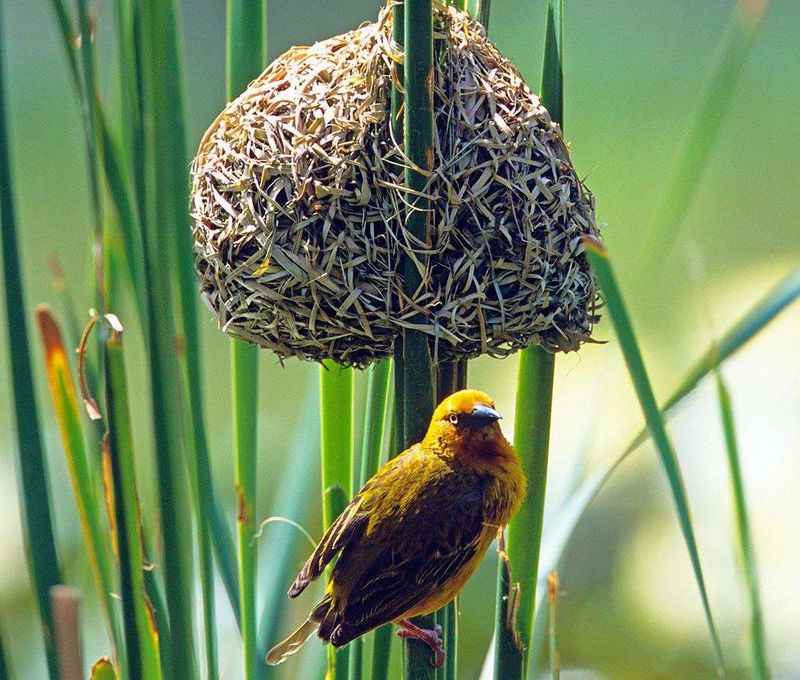
The Weaver Bird is synonymous with precision and skill in nest-building. Found in Africa, Asia, and parts of Australia, these birds construct nests that are architectural wonders. Using strips of grass and leaves, they weave intricate, secure nests that hang from branches.
Each nest is a masterclass in avian weaving, usually shaped like a hollow ball with a small entrance at the bottom to deter predators. The males are the primary builders, often creating several nests to attract a mate.
The construction process is a spectacle, with the bird meticulously intertwining each piece of material. If a female is impressed by the craftsmanship, she will move in, often leading to a breeding partnership.
The Weaver Bird’s nest not only serves as a secure home but also as a testament to its construction prowess, ensuring safety and comfort for the next generation.
4. Horned Coot
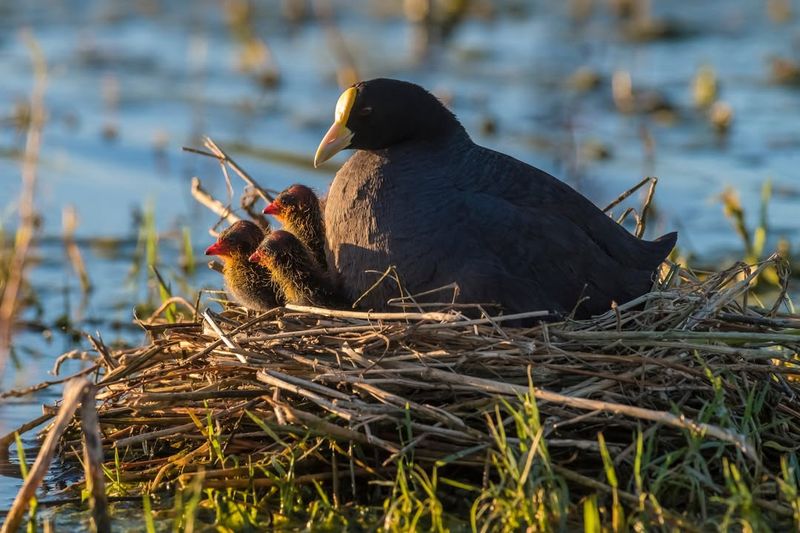
High in the Andes, the Horned Coot builds nests that are a unique blend of patience and resourcefulness. Unlike most birds, this coot constructs its nest primarily from pebbles, creating a mound that rises above the water’s surface.
The process is labor-intensive, requiring the bird to carry thousands of pebbles, one at a time, to its chosen site. This pebble mound provides a stable and secure platform for raising its young, safe from water-level fluctuations and predators.
The Horned Coot’s nesting strategy is a fascinating adaptation to its high-altitude aquatic environment, where resources are scarce and conditions can be harsh. Observing these nests, one witnesses the incredible determination and ingenuity of the Horned Coot, as it transforms simple stones into a safe haven for its offspring.
5. Common Tailorbird
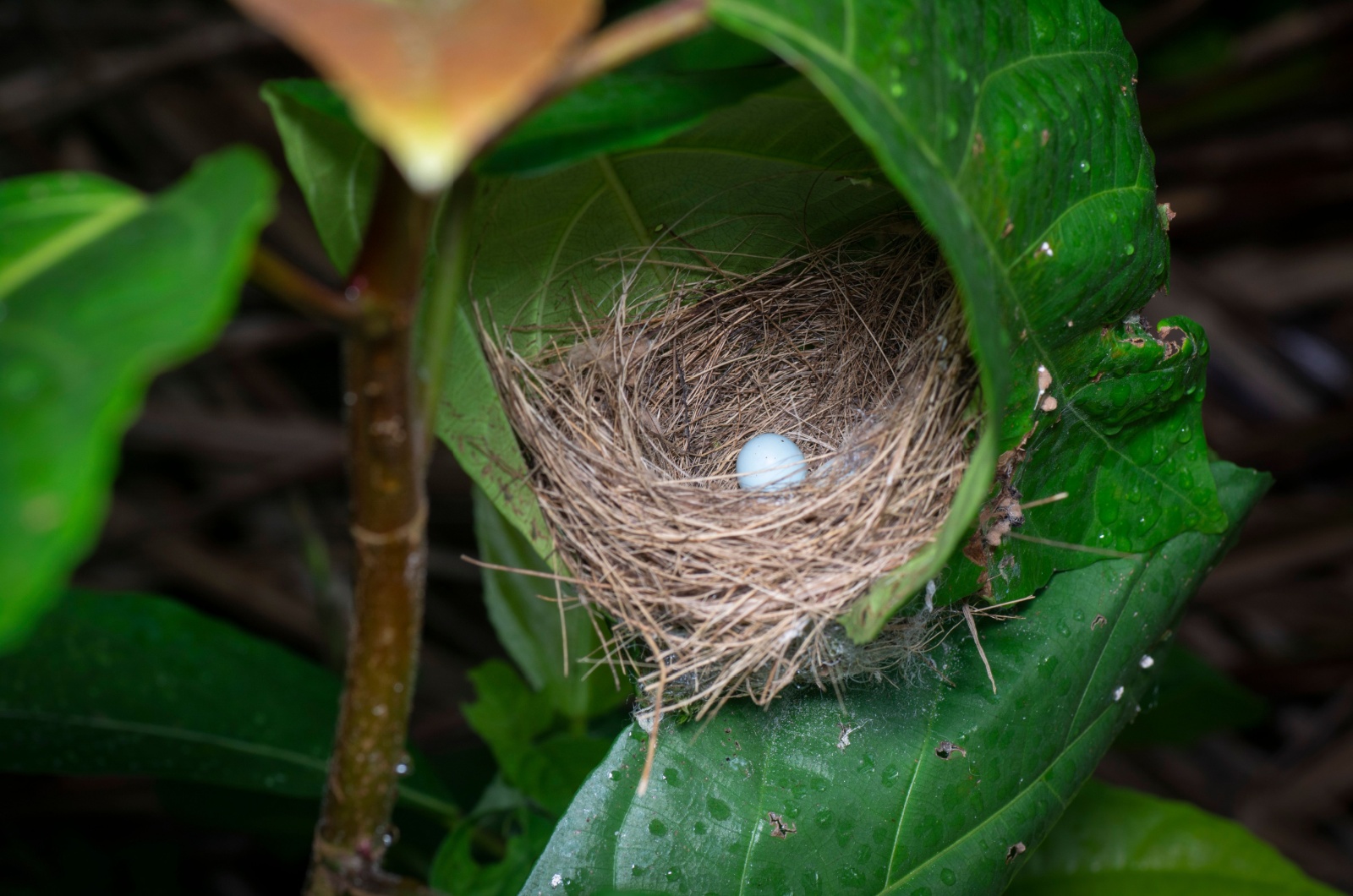
Shutterstock
In the bustling greenery of South Asia, the Common Tailorbird demonstrates remarkable sewing skills when building its nest. These small birds deftly stitch leaves together using plant fibers or spider silk, creating a cradle that blends seamlessly into the foliage.
The nest, usually suspended from branches, provides excellent camouflage against predators. The Tailorbird’s use of natural materials showcases their adaptability and resourcefulness, transforming simple leaves into a secure sanctuary for their eggs.
Observing the Common Tailorbird at work is a mesmerizing sight, as it flits between leaves, meticulously threading fibers with its sharp beak, ensuring a snug and hidden home. This artistic and functional creation highlights the bird’s capacity to manipulate its environment, crafting a home that is both protective and discreet.
6. Satin Bowerbird
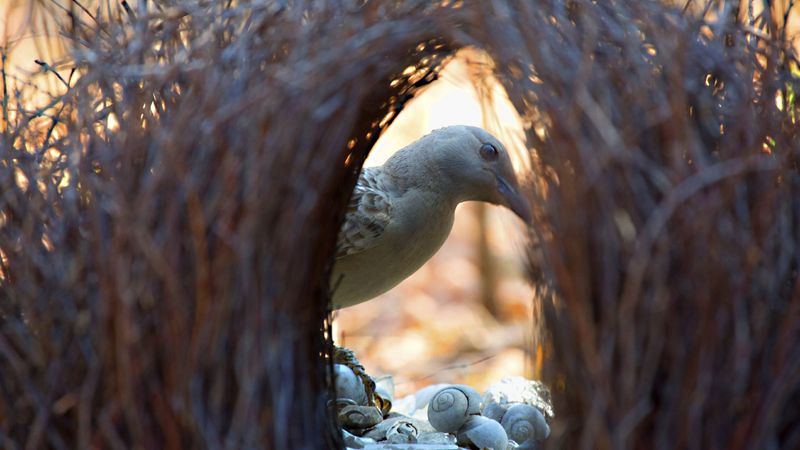
The Satin Bowerbird is an artist at heart, crafting bowers that are as much about aesthetics as they are about functionality. Situated in the forests of eastern Australia, these birds are known for their striking blue-themed displays.
Unlike nests used for rearing young, bowers serve as courtship arenas where males showcase their creativity to attract females. Each bower is meticulously arranged with blue objects, from flowers and berries to bottle caps and plastic pieces.
The male Satin Bowerbird’s ability to decorate and maintain this structure plays a crucial role in his mating success. Females assess the quality and creativity of the bower before choosing a mate, making these bowers a pivotal element in the reproduction process.
The Satin Bowerbird’s unique approach to nest-building highlights the intricate link between art and survival in the avian world.
7. Eastern Bluebird
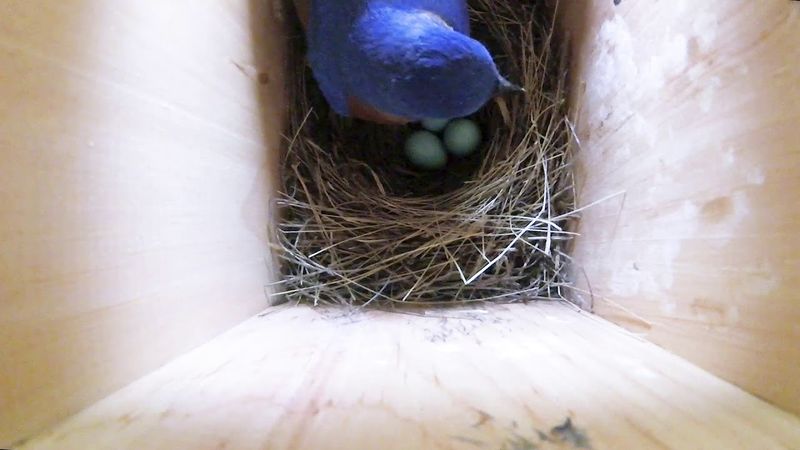
Nestled within tree cavities, the Eastern Bluebird constructs a simple yet effective home for its young. These birds utilize natural hollows or abandoned woodpecker holes, lining them with grasses, pine needles, and feathers to form a cozy nest.
This straightforward approach provides protection against the elements and predators, ensuring a safe environment for raising their offspring. The Eastern Bluebird’s choice of nesting sites often means they are limited by the availability of suitable cavities, making conservation efforts critical for their survival.
By understanding their nesting habits and providing artificial nesting boxes, humans can play a role in supporting Eastern Bluebird populations. This collaboration between species underscores the importance of habitat preservation and the impact of human intervention in wildlife conservation.
8. Hummingbird
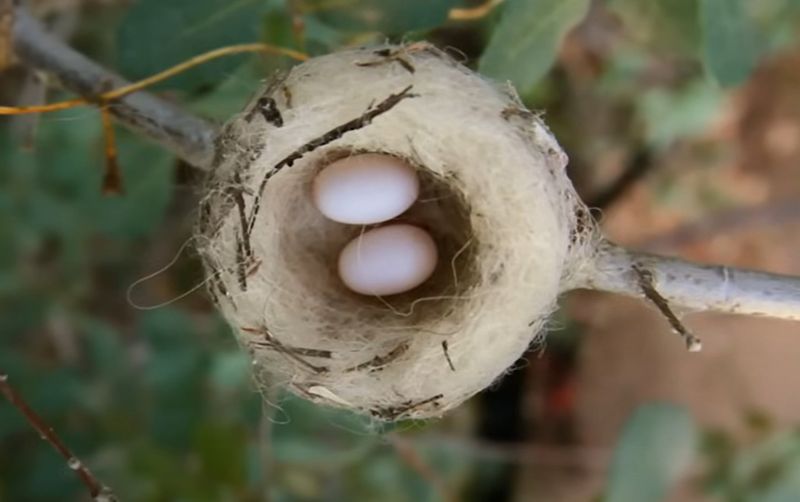
The diminutive Hummingbird is renowned for its delicate and intricately woven nests. Using plant down and spider silk, these birds create a tiny, yet sturdy cup that cradles their eggs. The elasticity of the spider silk allows the nest to expand as the chicks grow, showcasing the bird’s foresight in construction.
Perched precariously on branches, hummingbird nests are marvels of lightweight engineering. Their choice of materials not only provides a soft lining but also ensures that the nest is camouflaged among leaves and flowers.
This ingenious use of natural resources demonstrates the Hummingbird’s adaptability, crafting a secure and comfortable abode for its young. These nests, although small, are a testament to the Hummingbird’s exceptional building skills and resourcefulness in the wild.
9. Ovenbird
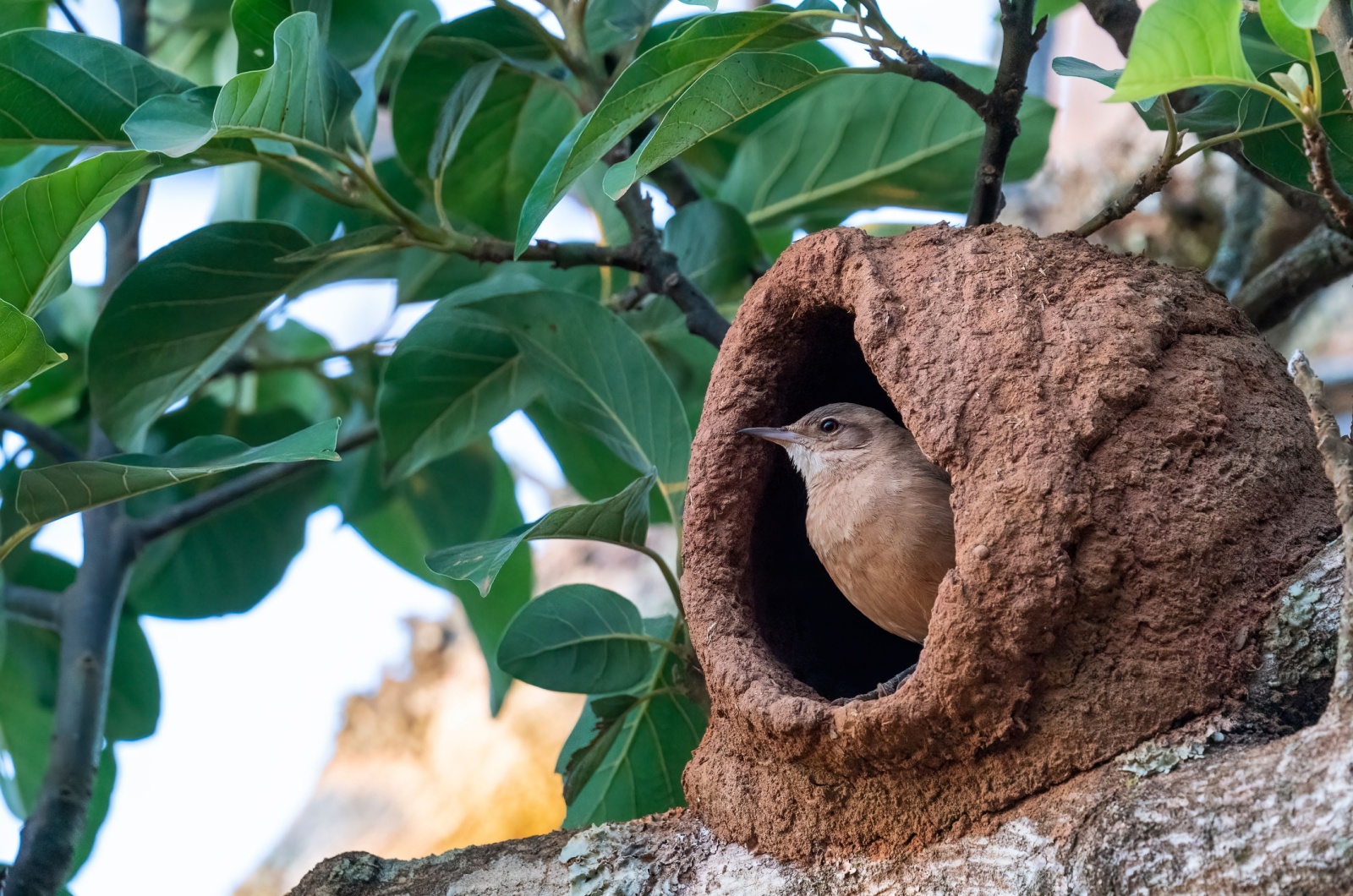
Shutterstock
The Ovenbird, named for its distinctive nest, constructs one of the most unique dwellings among birds. Resembling a small oven, the nest is built from mud and leaves, forming a dome-shaped structure on the forest floor.
This architectural feat provides excellent insulation and protection from predators, making it a safe haven for the bird’s eggs. The construction process involves gathering mud and leaves to create a sturdy wall, with a narrow entrance that deters intruders.
Ovenbirds are meticulous artisans, ensuring that their nests blend harmoniously with the forest surroundings.
This adaptation not only secures a nurturing environment for their young but also exemplifies the resourcefulness of these woodland architects. Observing an Ovenbird at work reveals the intricate balance between form and function in nature’s design.
10. European Reed Warbler
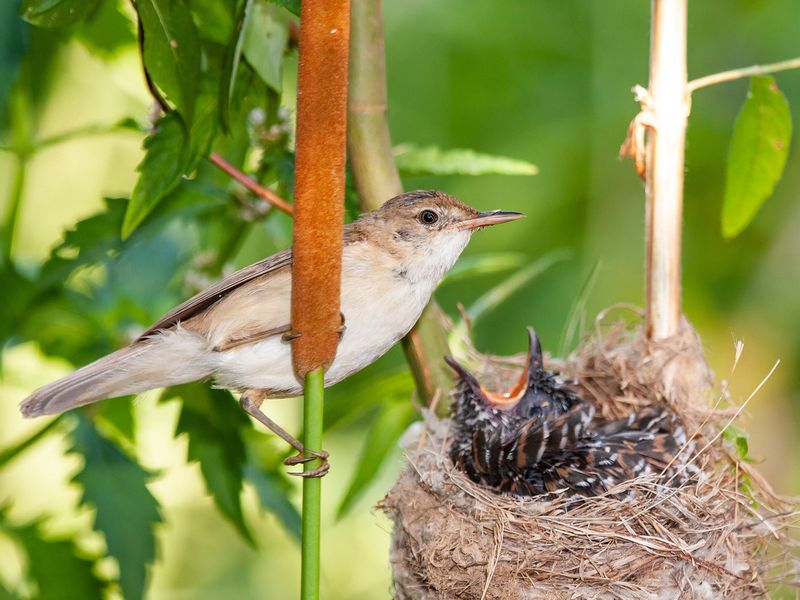
Amidst the dense reeds of Europe’s wetlands, the European Reed Warbler showcases its weaving prowess. These birds construct hanging nests that sway gently with the wind, cleverly positioned among the reeds to remain concealed from predators.
The nest is ingeniously woven from grass and spider silk, forming a secure, cup-like structure. This choice of location offers protection from rising water levels and ground-based threats, while the materials provide flexibility and strength.
Observing a Reed Warbler at work is a testament to its adaptability and the importance of its wetland habitat. The nest’s strategic placement and construction ensure a stable and nurturing environment for their offspring, reflecting the bird’s intimate connection with its natural surroundings.
11. Montezuma Oropendola
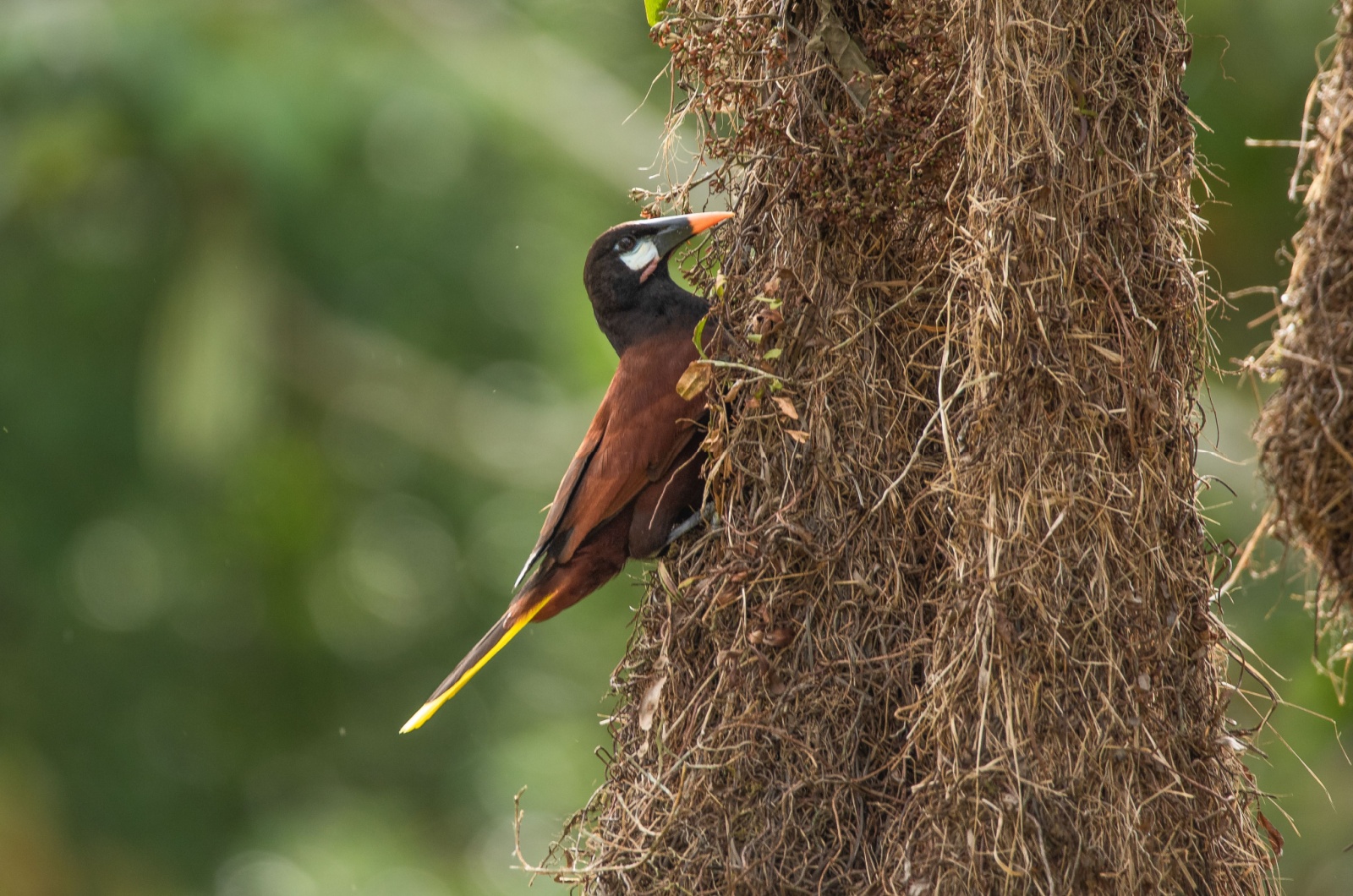
Shutterstock
In the lush rainforests of Central America, the Montezuma Oropendola builds impressive, pendulous nests that dangle from tall trees. These nests, woven from vines and grasses, hang like elongated teardrops, sometimes reaching lengths of over six feet.
Their unique design not only showcases the Oropendola’s weaving skills but also serves as a deterrent to predators. Hanging high above the ground, the nests are safe havens from terrestrial threats and are strategically placed to sway gently in the wind.
This movement may help deter predators and parasites, providing a secure environment for rearing young. The Montezuma Oropendola’s choice to build high in the canopy reflects its adaptability and prowess in utilizing available resources to ensure the survival of its offspring.
12. Penduline Tit
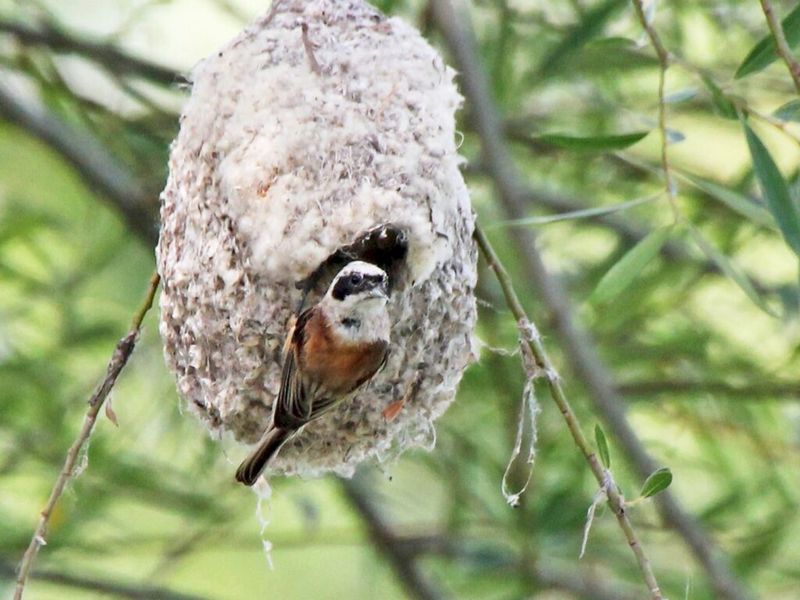
The Penduline Tit is renowned for crafting intricately woven nests that hang delicately from tree branches. Using plant fibers and animal hair, these birds create a soft, secure pouch with a narrow entrance, a design that provides excellent protection against predators.
The craftsmanship involved is meticulous, as the birds weave the material into a dense, warm cocoon for their eggs. These nests are marvels of natural engineering, with the entrance often concealed or equipped with a flap that can be adjusted to hide the interior.
This strategic design ensures not only safety but also comfort, as the materials used provide insulation against the elements. The Penduline Tit’s ability to create such an elaborate structure highlights its adaptability and ingenuity in the wild, ensuring a safe haven for its young.
13. Sunbird
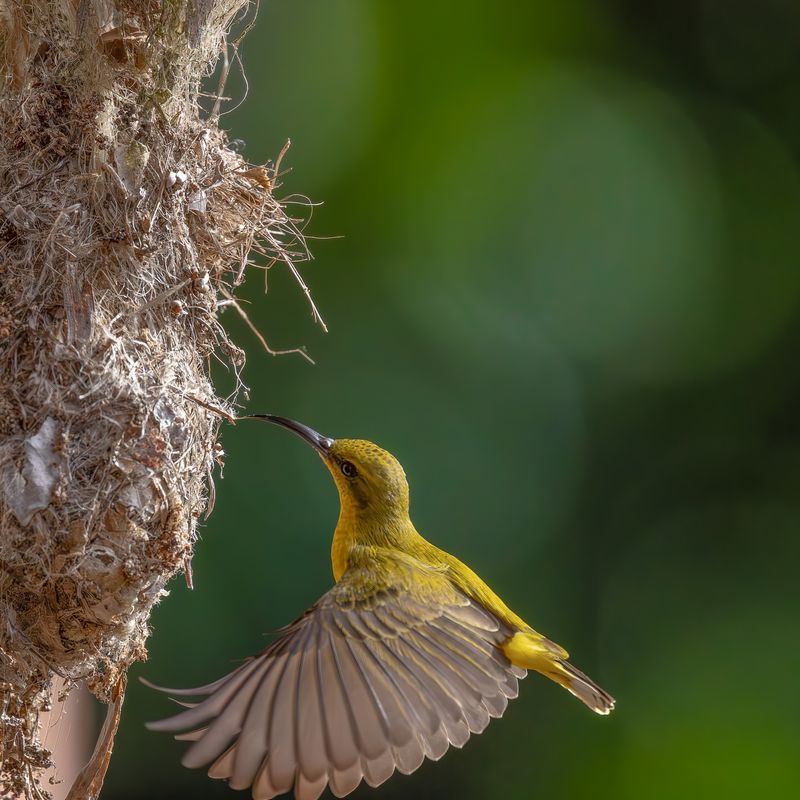
In the tropical regions of Africa and Asia, Sunbirds are master architects of hanging nests. They use materials such as leaves, spider webs, and even pieces of bark to construct a small, enclosed structure that hangs from tree branches.
The exterior is often adorned with lichen and moss, providing excellent camouflage against predators. The construction of the Sunbird’s nest is a delicate process, requiring precise placement of materials to ensure stability and security.
The use of spider webs is particularly ingenious, as it allows the nest to expand slightly as the chicks grow. These nests not only serve as safe incubation sites but also demonstrate the Sunbird’s exceptional ability to adapt to its environment, creating a hidden sanctuary amidst the foliage.
14. Hill Myna
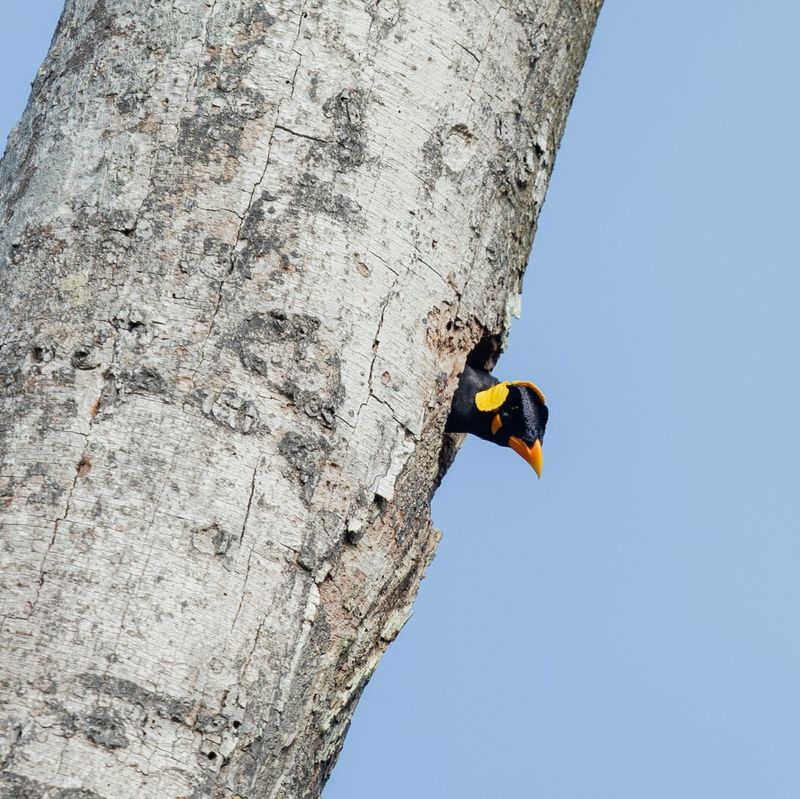
The Hill Myna is renowned for its vocal mimicry, but its nest-building skills are equally fascinating. These birds favor dense forests in Southeast Asia for their nesting sites, constructing their homes high in the trees.
Using leaves, twigs, and fibers, Hill Mynas create compact nests that are inconspicuous yet sturdy. The choice of location not only offers camouflage but also provides a cooler, more humid environment conducive to raising chicks.
Their nests reflect a keen understanding of their habitat, blending seamlessly with their surroundings.
15. Village Weaver
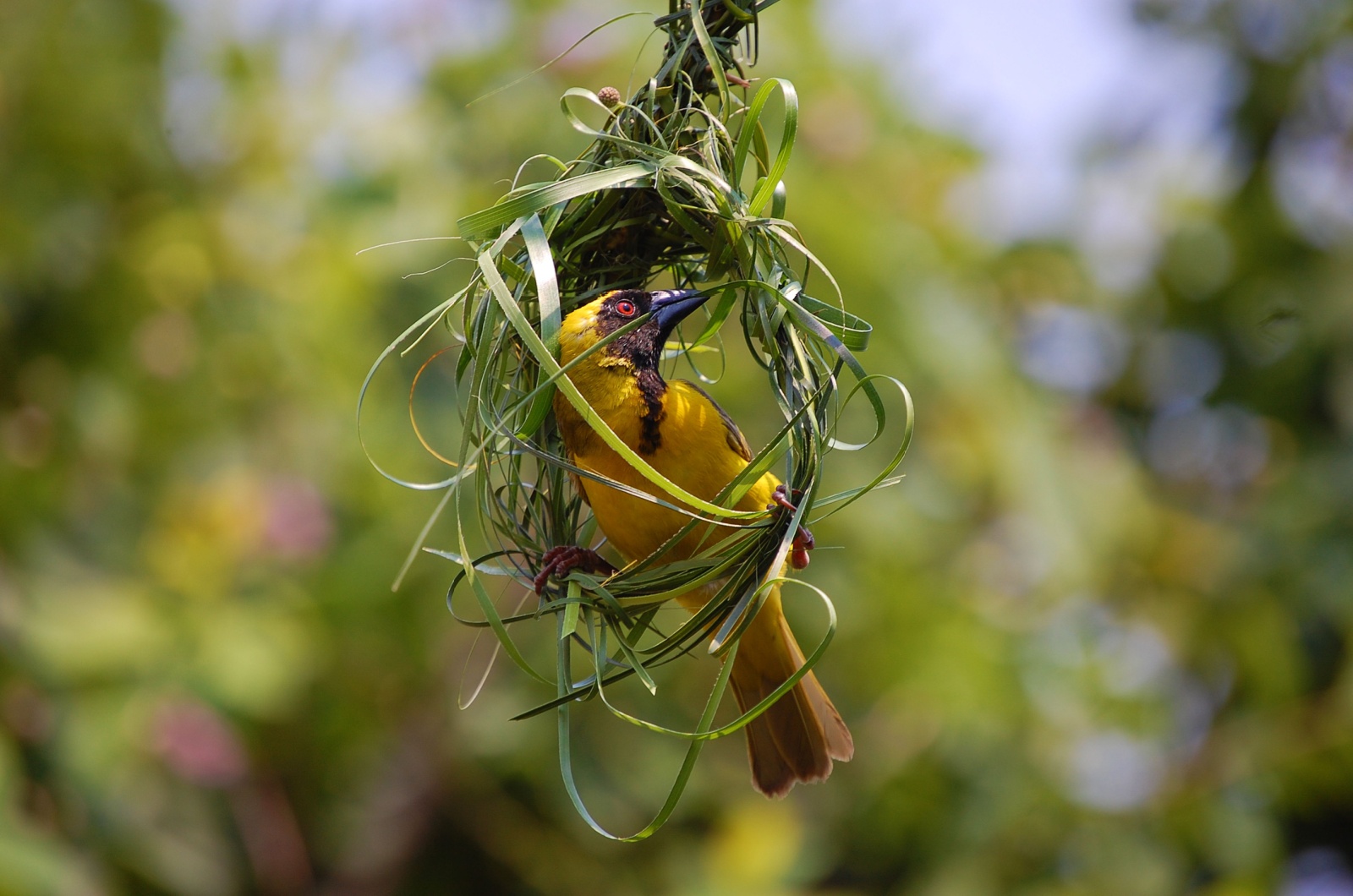
Shutterstock
The Village Weaver is a highly skilled architect, known for constructing intricate spherical nests. Found across sub-Saharan Africa, these birds build their homes using strips of grass and leaf fibers, creating a structure that hangs securely from tree branches. The design includes a small entrance that helps protect against predators.
These nests are often built in colonies, with each male constructing multiple nests to attract females. The construction process is a fascinating display of precision and skill, as the bird weaves the materials tightly together to form a resilient and comfortable home.
The Village Weaver’s dedication to nest-building not only ensures the safety and comfort of its young but also reflects the bird’s adaptability and cooperative nature in the wild.

